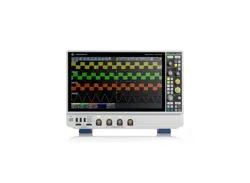Loading ...
Loading ...
Loading ...

Acquisition and waveform setup
R&S
®
MXO 5 Series
105User Manual 1802.3369.02 ─ 02
6.2.1 About the acquisition system
Sampling and processing
The A/D converter samples the continuous signal under test at specific points in time
and captures digital values. The converter is working at a constant rate specified in
GHz.
The captured values are processed according to the acquisition settings. The result is
a waveform record that contains waveform samples and is stored in the waveform
memory. The waveform samples are displayed on the screen and build up the wave-
form.
The number of waveform samples in one waveform record is called record length.
The rate of recording waveform samples - the number of waveform samples per sec-
ond - is the sample rate. The higher the sample rate, the better the resolution is and
the more details of the waveform are visible.
Sample rate = 1 / Resolution
The sample rate can be the same as the constant rate of the A/D converter, or higher,
or lower. To get a higher sample rate, interpolation is used. Several interpolation meth-
ods are available. Other processing methods reduce the sample rate, or build the
resulting waveform from several consecutive acquisitions of the signal. These methods
are called acquisition modes.
Minimum sample rate and aliasing
A sufficient resolution is essential for correct reconstruction of the waveform. If the sig-
nal is undersampled, aliasing occurs - a false waveform is displayed. To avoid aliasing
and accurately reconstruct a signal, the sample rate must be at least 3 to 5 times the
fastest frequency component of the signal. A higher sample rate increases signal fidel-
ity, increases the chance to capture glitches and other signal anomalies, and improves
the zoom-in capabilities.
Interleaving
The R&S MXO 5 with 8 channels achieves its highest sample rate of 5 Gsample/s by
interleaving channels by twos. Interleaving assumes that only one of the paired chan-
nels is used. If the second channel of a pair is used (on display, or as trigger source,
math source, or measurement source), the interleaving mode is disabled. Without
interleaving, the channels work with 2.5 Gsample/s and reduced bandwidth.
Acquisition
Loading ...
Loading ...
Loading ...
